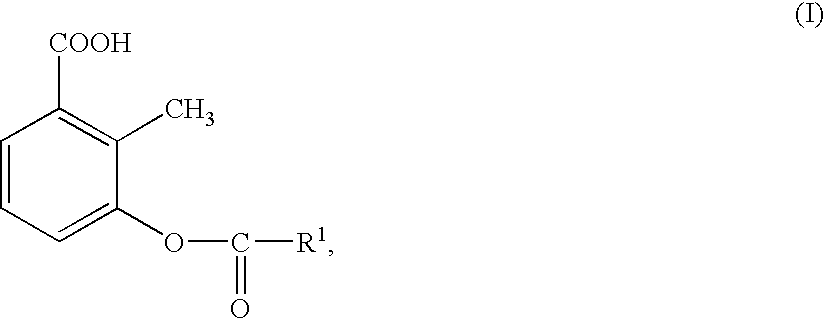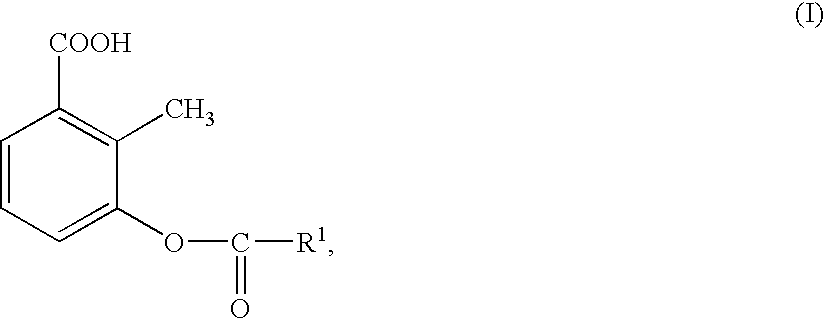Preparation of 3-acyloxy-2-methylbenzoic acids
- Summary
- Abstract
- Description
- Claims
- Application Information
AI Technical Summary
Problems solved by technology
Method used
Image
Examples
example 1
[0097]In a nickel autoclave, 300.0 g of trisodium 1,3,5-naphthalenetrisulphonate (70.9%, determined as the free acid) are stirred into a mixture of 232.0 g of aqueous sodium hydroxide solution (45%) and 194.0 g of sodium hydroxide in such a way that a readily stirrable, pasty suspension is obtained. The autoclave is closed and heated to 280° C. The internal pressure (autogenous pressure) rises to 18.4 bar. The mixture is stirred at reaction temperature for a further 6 hours and is cooled afterwards to 90° C. At this temperature, 200.0 g of water are pumped in and the mixture is cooled afterwards to room temperature. The suspension obtained is filtered with suction and washed with 187.3 g of water. 251.8 g of a brownish-white, finely divided solid and 795.7 g of a dark brown solution are obtained.
example 2
[0098]A flask is initially charged with 390.0 g of the solution from Example 1. 20.0 g of activated carbon are added and the pH is set to 7.0 by metering in hydrochloric acid (37%), the mixture is heated to reflux, the reaction solution is clarified and washed with water. The clarified reaction solution is returned to the flask, cooled to 0° C. and set to pH 9.6 by metering in sodium hydroxide solution (30%). Acetic anhydride and sodium hydroxide solution are now metered in simultaneously at 0 to 5° C. in such a way that the pH remains in the range from 9.3 to 9.7. Within 1 hour, 39.8 g of acetic anhydride and 75.9 g of sodium hydroxide solution (30%) are metered in. Afterwards, stirring is continued at the same temperature for 0.5 hour. Afterwards, the pH is set to 1 at 5° C. by adding hydrochloric acid. The product precipitates out as a white precipitate. The product is filtered off with suction on a glass suction filter and washed with water. The precipitate is dried in a vacuum ...
example 3
[0099]In a nickel autoclave, 300.0 g of trisodium 1,3,5-naphthalenetrisulphonate (70.9%, determined as the free acid) are stirred into a mixture of 356.0 g of aqueous sodium hydroxide solution (45%) and 126.0 g of sodium hydroxide pastilles and 127.0 g of calcium hydroxide in such a way that a readily stirrable, pasty suspension is obtained. The autoclave is closed and heated to 310° C. The internal pressure (autogeneous pressure) rises to 50 bar. The mixture is stirred at reaction temperature for a further 5 hours and is cooled afterwards to 90° C. At this temperature, 200.0 g of water are pumped in and the mixture is cooled afterwards to room temperature. The suspension obtained is filtered with suction and washed with 609.6 g of water. 295.0 g of a brownish-white, finely divided solid and 1388.8 g of a dark brown solution are obtained.
PUM
| Property | Measurement | Unit |
|---|---|---|
| Acidity | aaaaa | aaaaa |
| Solubility (mass) | aaaaa | aaaaa |
Abstract
Description
Claims
Application Information
 Login to view more
Login to view more - R&D Engineer
- R&D Manager
- IP Professional
- Industry Leading Data Capabilities
- Powerful AI technology
- Patent DNA Extraction
Browse by: Latest US Patents, China's latest patents, Technical Efficacy Thesaurus, Application Domain, Technology Topic.
© 2024 PatSnap. All rights reserved.Legal|Privacy policy|Modern Slavery Act Transparency Statement|Sitemap



